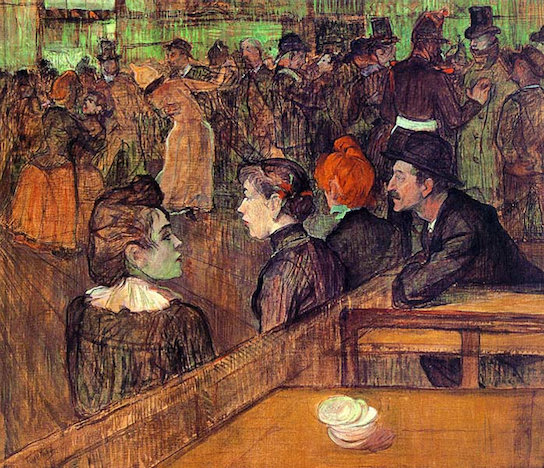Henry Toulouse-Lautrec (1864-1901)
An aristocratic, alcoholic dwarf known for his louche lifestyle, Henri de Toulouse-Lautrec created art that was inseparable from his legendary life. His career lasted just over a decade and coincided with two major developments in late nineteenth-century Paris: the birth of modern printmaking and the explosion of nightlife culture. Lautrec’s posters promoted Montmartre entertainers as celebrities, and elevated the popular medium of the advertising lithograph to the realm of high art. His paintings of dancehall performers and prostitutes are personal and humanistic, revealing the sadness and humor hidden beneath rice powder and gaslights. Though he died tragically young (at age thirty-six) due to complications from alcoholism and syphilis, his influence was long-lasting. It is fair to say that without Lautrec, there would be no Andy Warhol.
An aristocratic, alcoholic dwarf known for his louche lifestyle, Henri de Toulouse-Lautrec created art that was inseparable from his legendary life.
Lautrec began drawing at a young age, when frequent illnesses (portending more serious health problems to come) kept him bedridden at the family estate in Albi in southern France. His favorite juvenile subject was the horse, as seen in the sketch of Two Riders on Horseback. This probably was owed to the influence of his first teacher, René Princeteau (1844–1914), a close family friend and deaf-mute who painted fashionable sporting pictures. Lautrec’s fascination for horses endured throughout his career, as seen in his 1899 work At the Circus: The Spanish Walk, one of a group of colored chalk drawings Lautrec made from memory while recovering at a sanatorium, offered to doctors as proof of his improving health.
Due to a genetic weakness resulting from the consanguineous marriage of his parents (who were first cousins), Lautrec’s legs ceased growing after he broke both his femur bones in separate, minor accidents during his adolescence. As an adult, Lautrec had a normally proportioned upper body, but the stubby legs of a dwarf; his mature height was barely five feet, and he walked with great difficulty using a cane. Lautrec compensated for his physical deformities with alcohol and an acerbic, self-deprecating wit. His sympathy and fascination for the marginal in society, as well as his keen caricaturist’s eye, may be partly explained by his own physical handicap.
In 1882, Lautrec moved from Albi to Paris, where he studied art in the ateliers of two academic painters, Léon Bonnat (1833–1922) and Fernand Cormon (1845–1924), who also taught Émile Bernard (1868–1941) andVincent van Gogh (1853–1890). Lautrec soon began painting en plein air in the manner of the Impressionists, and often posed sitters in the Montmartre garden of his neighbor, Père Forest, a retired photographer. One of his favorite models was a prostitute nicknamed La Casque d’Or (Golden Helmet), seen in the painting The Streetwalker. Lautrec used peinture à l’essence, or oil thinned with turpentine, on cardboard, rendering visible his loose, sketchy brushwork. The transposition of this creature of the night to the bright light of day—her pallid complexion and artificial hair color clash with the naturalistic setting—signals Lautrec’s fascination with sordid and dissolute subjects. Later in his career, he would devote an entire series of prints, called Elles, to life inside a brothel.
Lautrec eventually established himself as the premier poster artist of Paris and was often commissioned to advertise famous performers in his prints. One of Lautrec’s favorite café-concert stars was Yvette Guilbert, who was known as a diseuse or «speaker» for the way she half-sung, half-spoke her songs during performances. She had bright red hair, thin lips, a tall gaunt physique, and wore black elbow-length gloves. Though her head is cropped by the top edge of the composition, her elongated body and trademark gloves in the upper left corner of the poster Divan Japonais leave no doubt as to her identity. Likewise, the pinched features and aloof demeanor of the singer Jane Avril, seated in the foreground of the image wearing one of her famously outlandish hats, are also subjected to Lautrec’s crystallizing vision. By exaggerating the characteristic features of these women, Lautrec conveyed the essence of their personalities.
The style and content of Lautrec’s posters were heavily influenced by Japanese ukiyo-e prints. Areas of flat color bound by strong outlines, silhouettes, cropped compositions, and oblique angles are all typical of woodblock prints by artists like Katsushika Hokusai (1760–1849) and Ando Hiroshige (1797–1858). Likewise, Lautrec’s promotion of individual performers is very similar to the depictions of famous actors, actresses, and courtesans from the so-called «floating world» of Edo-period Japan. For instance, Lautrec’s poster of May Belfort (41.12.1) can be compared with the figure of Iwai Hanshiro V (a male actor in female guise) in Three Kabuki Actors by Utagawa Kuniyasu (1794–1832).
Lautrec’s prints often display dazzling technical effects, as new innovations in lithography during the late nineteenth century permitted larger prints, more varied colors, and nuanced textures. The artist frequently employed the spattered ink technique known as crachis, seen in his series of prints depicting Miss Loïe Fuller . Fuller was an American famous in fin-de-siècle Paris for her performances combining dance, multicolored artificial lights (her nickname was the «Electric Fairy»), and music. As she twirled and bounded across the stage, enormous lengths of fabric would billow outward from her body and reflect the colored lights, creating a spectacular effect. Lautrec executed about sixty versions of this print in a variety of colored inks, including gold and silver, which evoke, cumulatively, the effect of her performances.
Lautrec’s poignant depiction of a prostitute in the painting Woman before a Mirror offers a counterpoint to the dazzling exuberance of Miss Loïe Fuller. Nude save for her black stockings, the woman stands straight-backed as she gazes into a looking glass, dispassionately analyzing her body’s attributes and faults. Meanwhile, the viewer is compelled to do the same, as we are presented with both her ample backside and her blurred reflection. Lautrec presents her neither as a moralizing symbol nor a romantic heroine, but rather as a flesh-and-blood woman (the dominant whites and reds in the composition reinforce this reading), as capable of joy or sadness as anyone. Indeed, the directness and honesty of the picture testify to Lautrec’s love of women, whether fabulous or fallen, and demonstrates his generosity and sympathy toward them.
Cora Michel

















